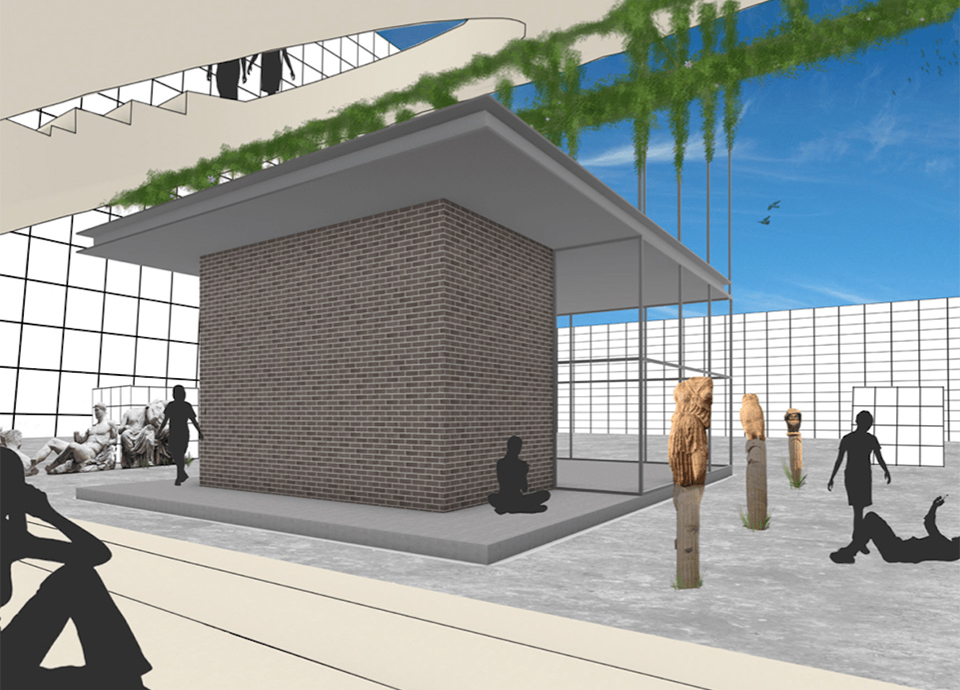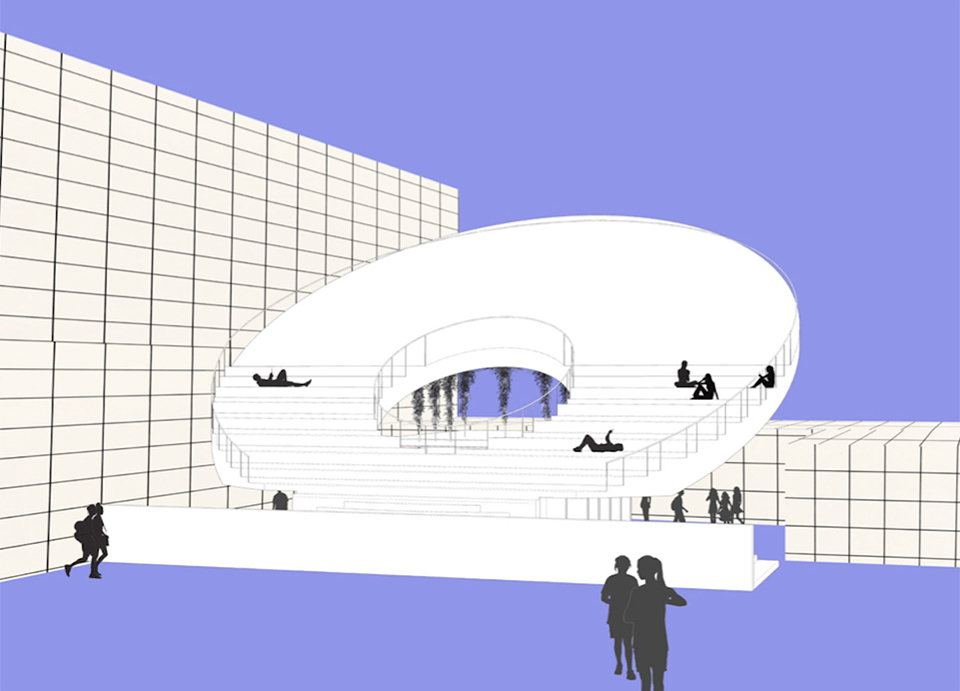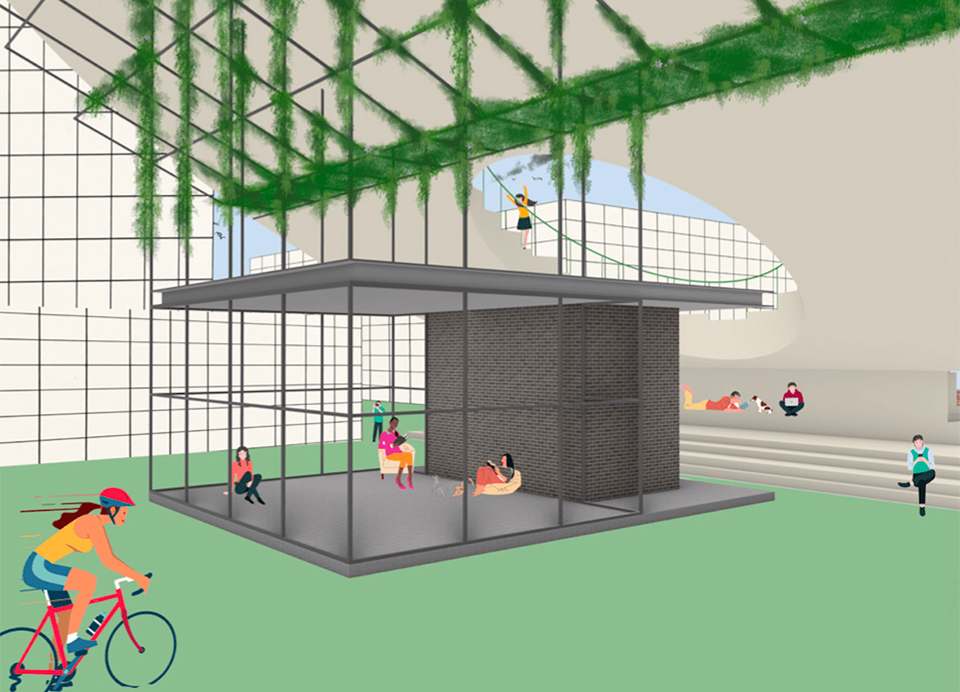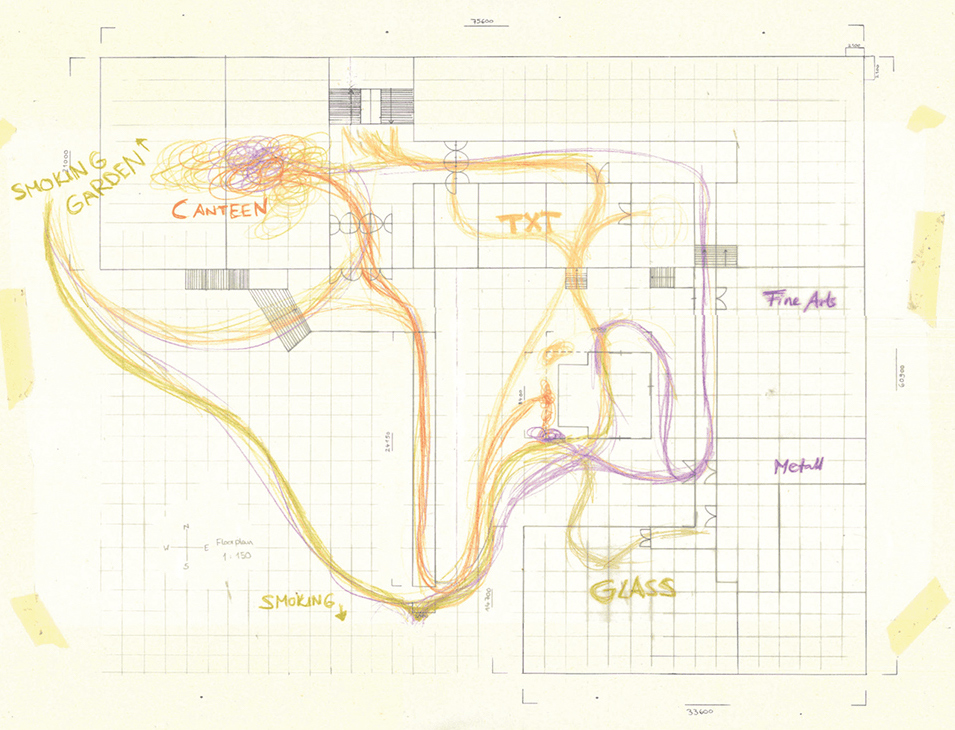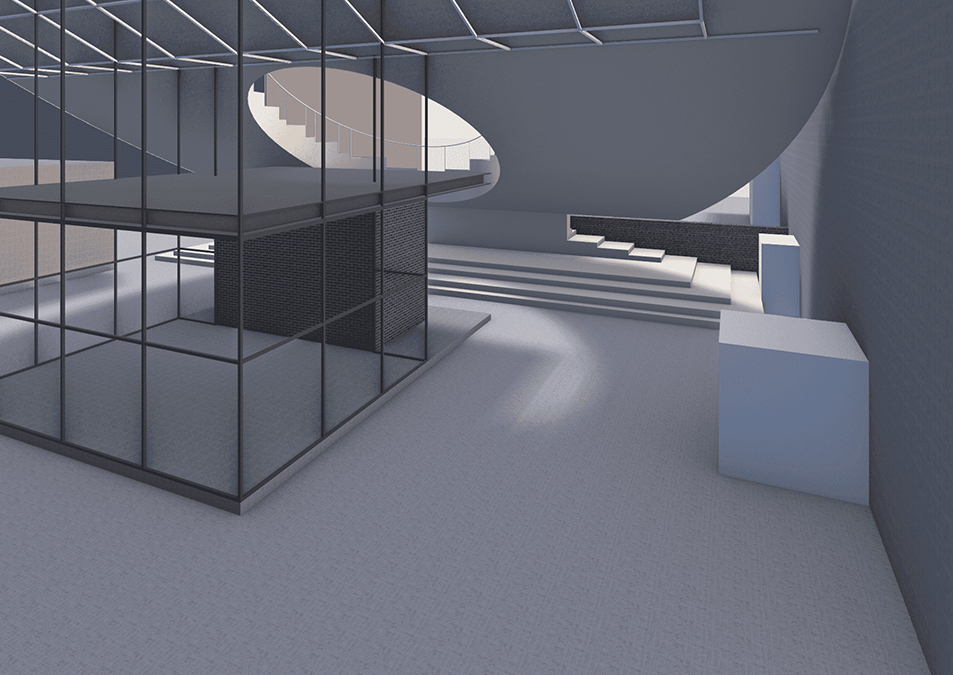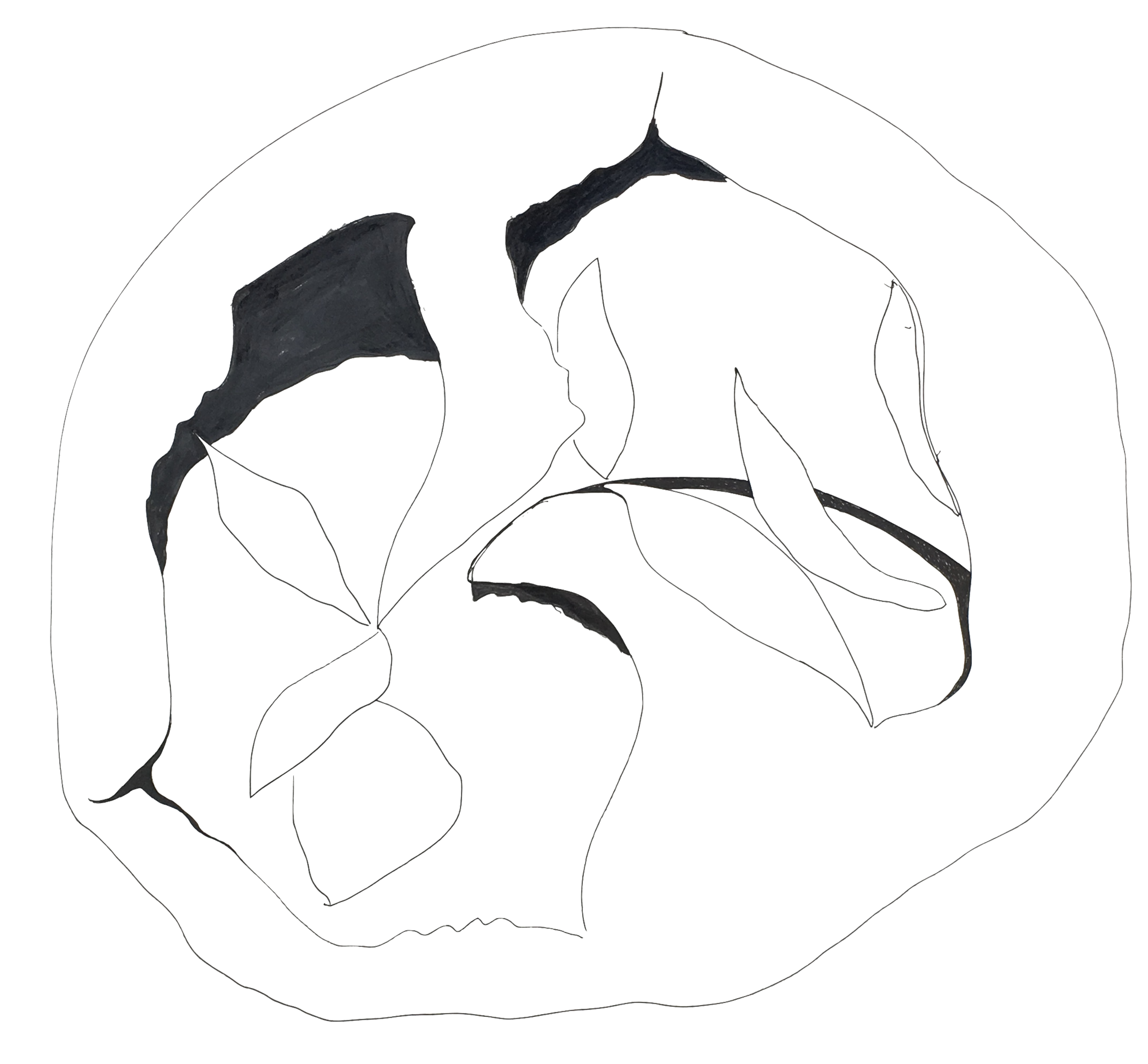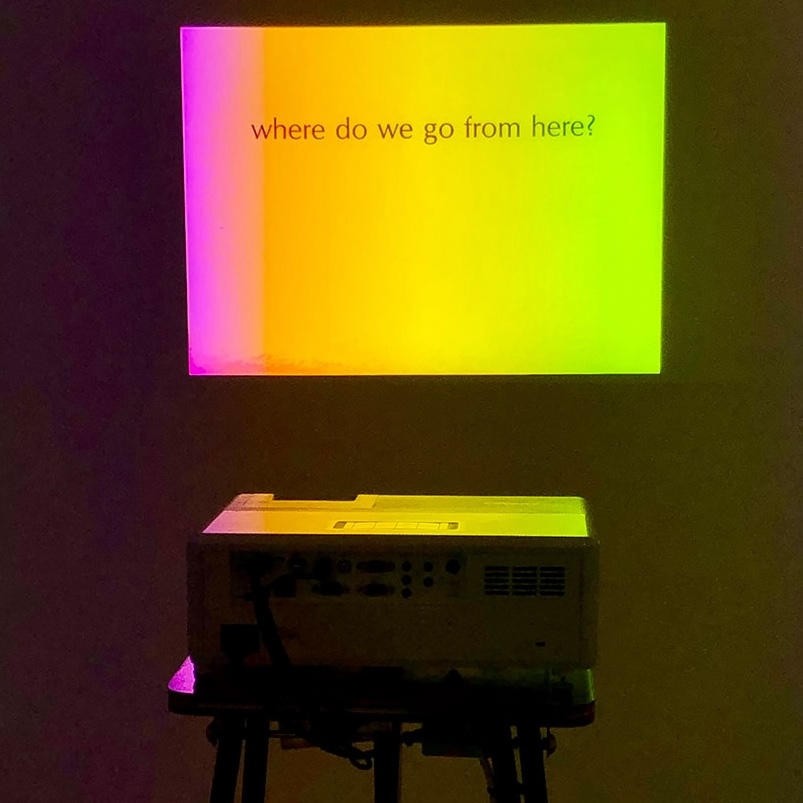

a more-than-human window
residency "the window", sectie-c, eindhoven. spring 2025
a project by Sectie-C
in collaboration with rewild farming
during a three month residency, at a creative hub in Eindhoven, we co-created a space centred around more-than-humanness. The project explored commoning as a governance practice, aiming to distribute authority and agency more horizontally in the design and activation of the space. Through weekly reading sessions on authors dealing with more-than-human ontologies, as well as experimentation with living matter, the project engaged with organisms such as mushrooms, bacteria and plants. we experimented with decision-making processes that responded to non-human presences, opening up discussions around how spatial governance might shift when non-human actants are treated as participants.
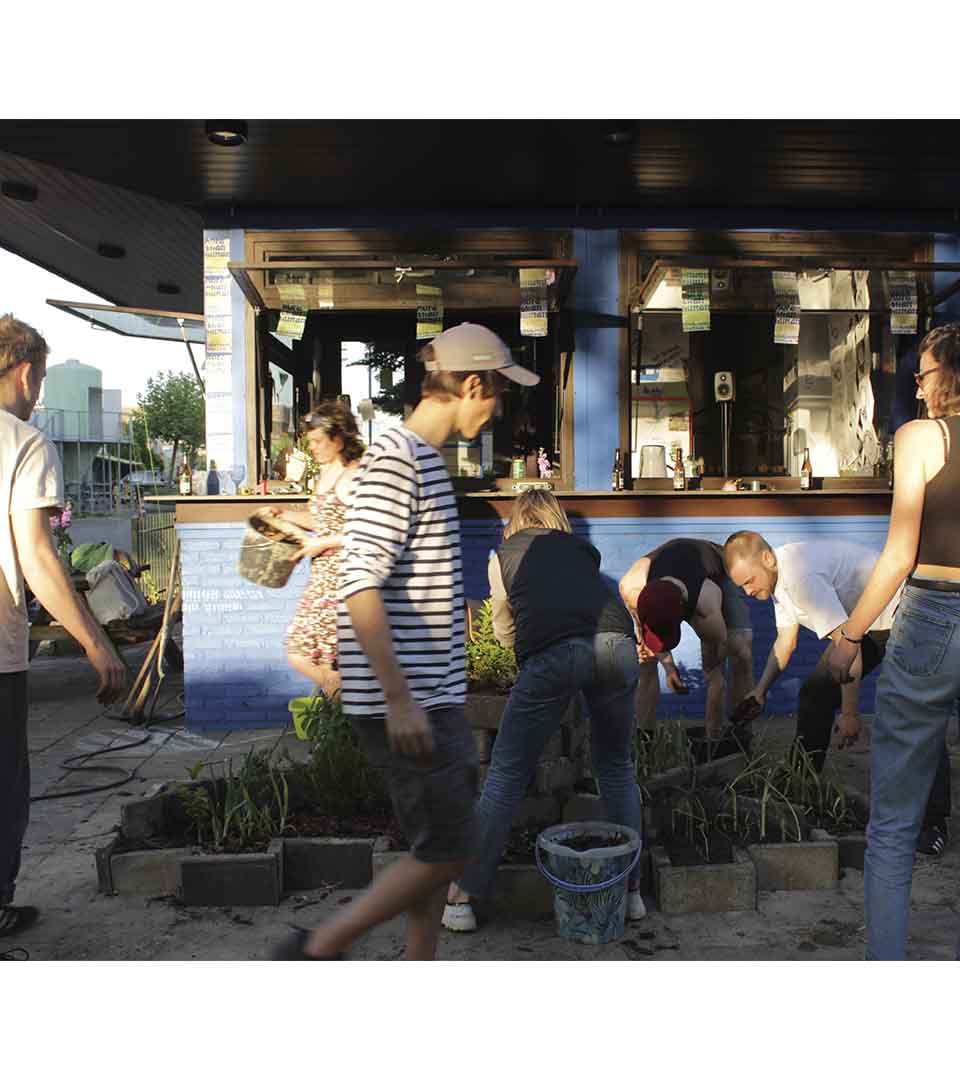
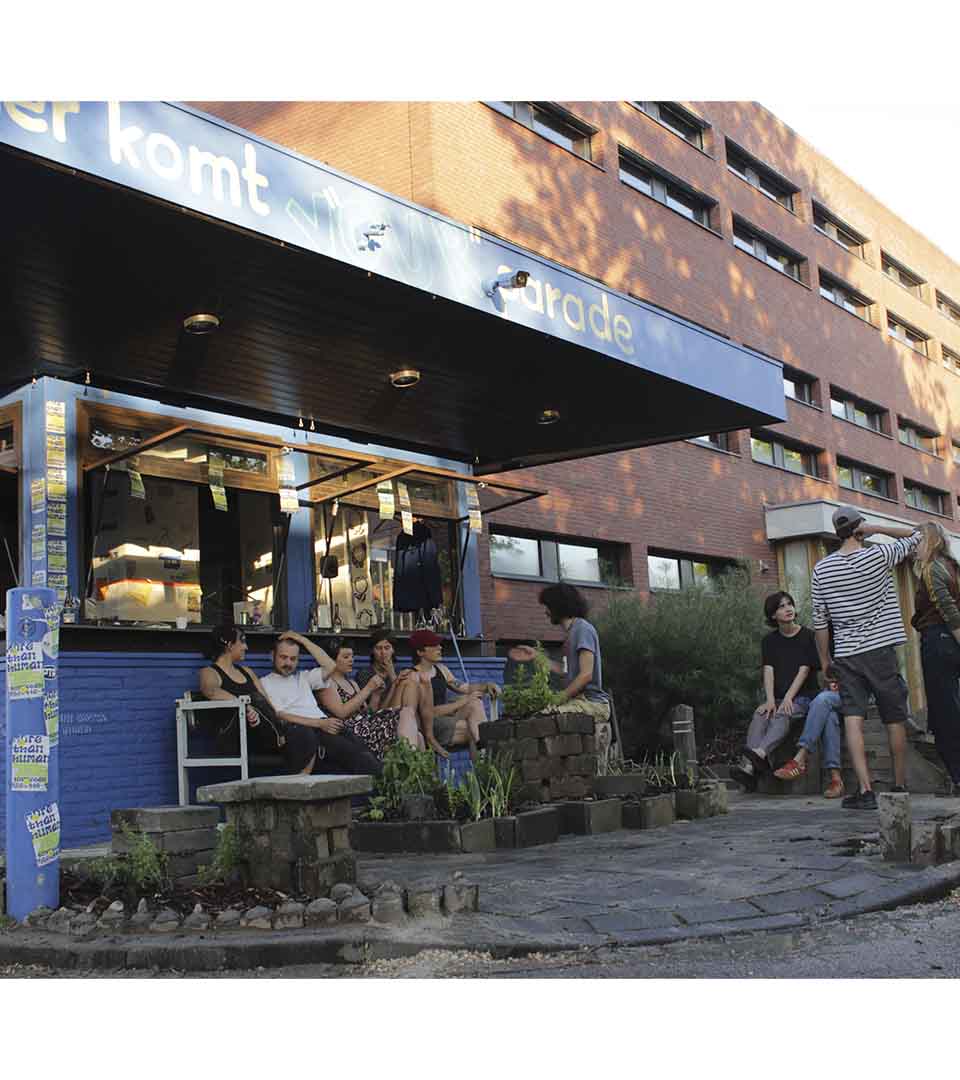
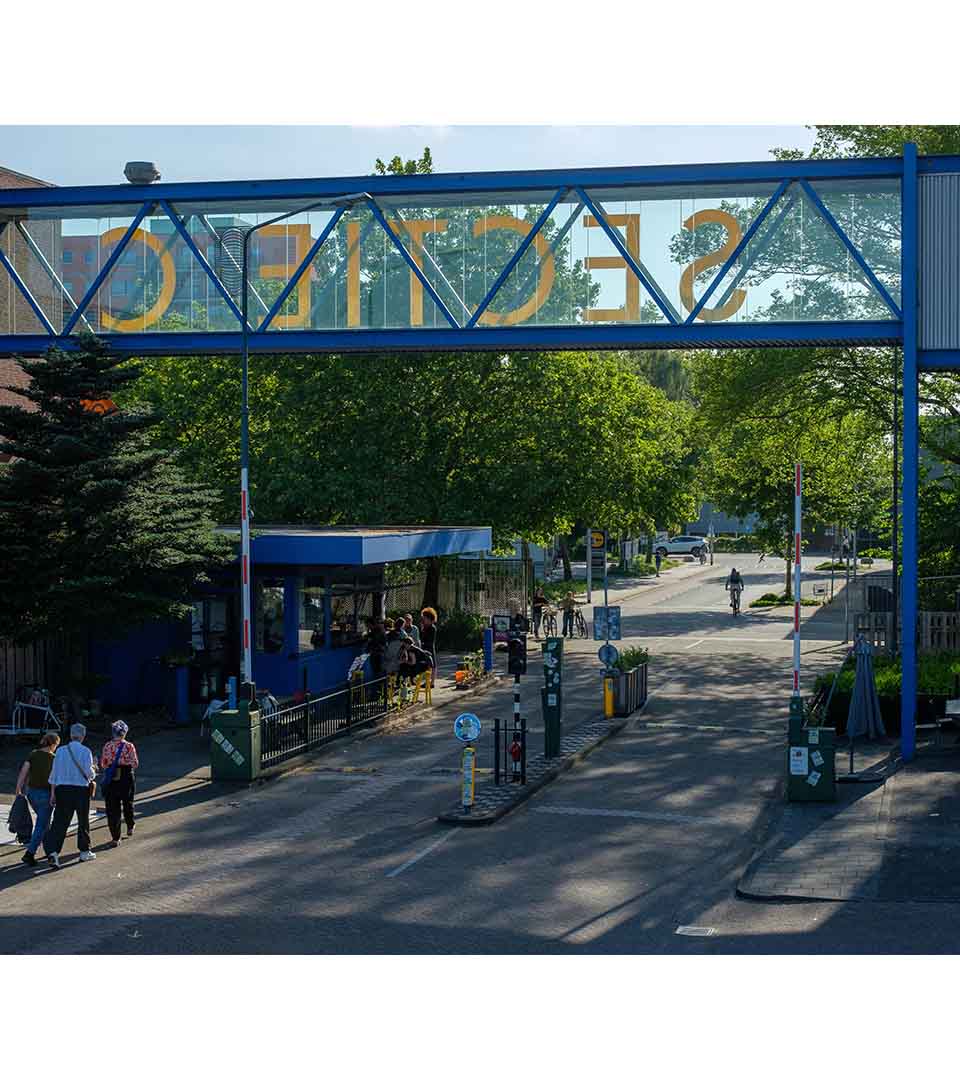
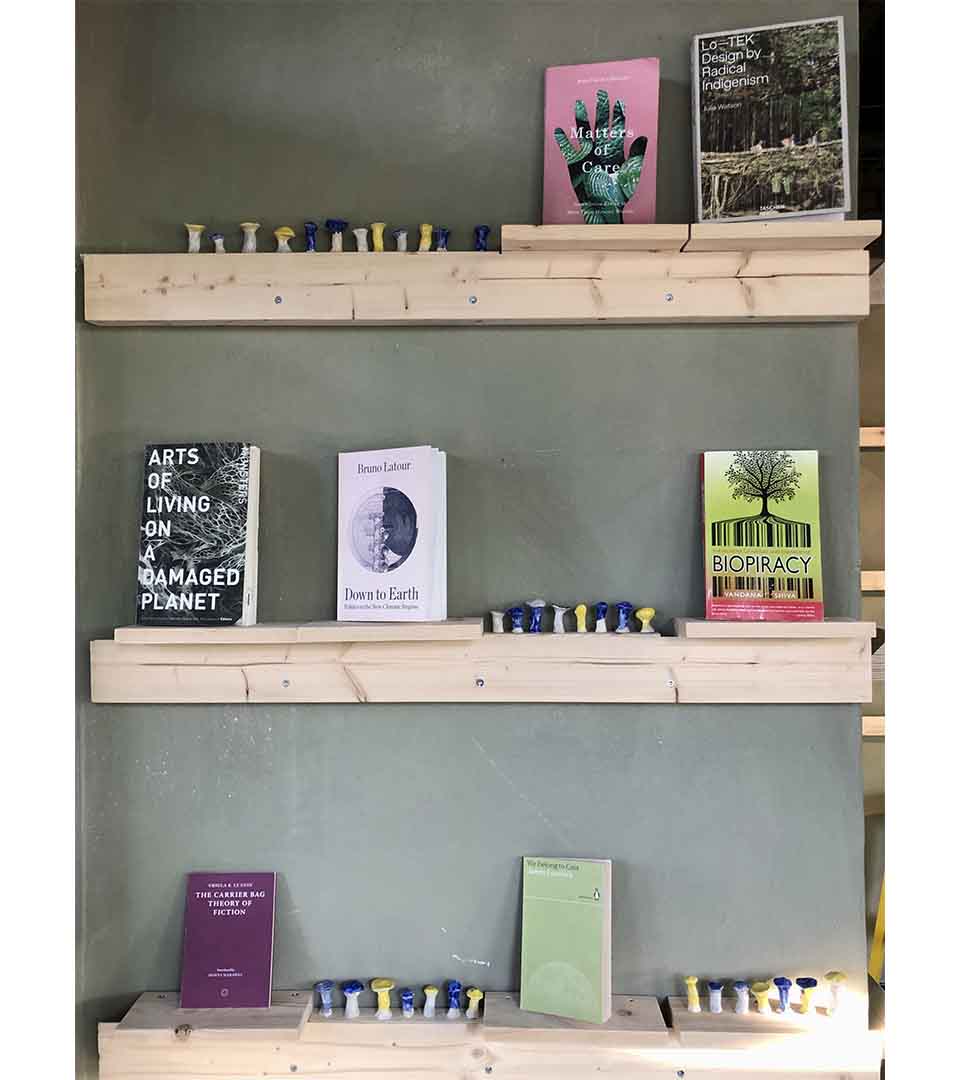

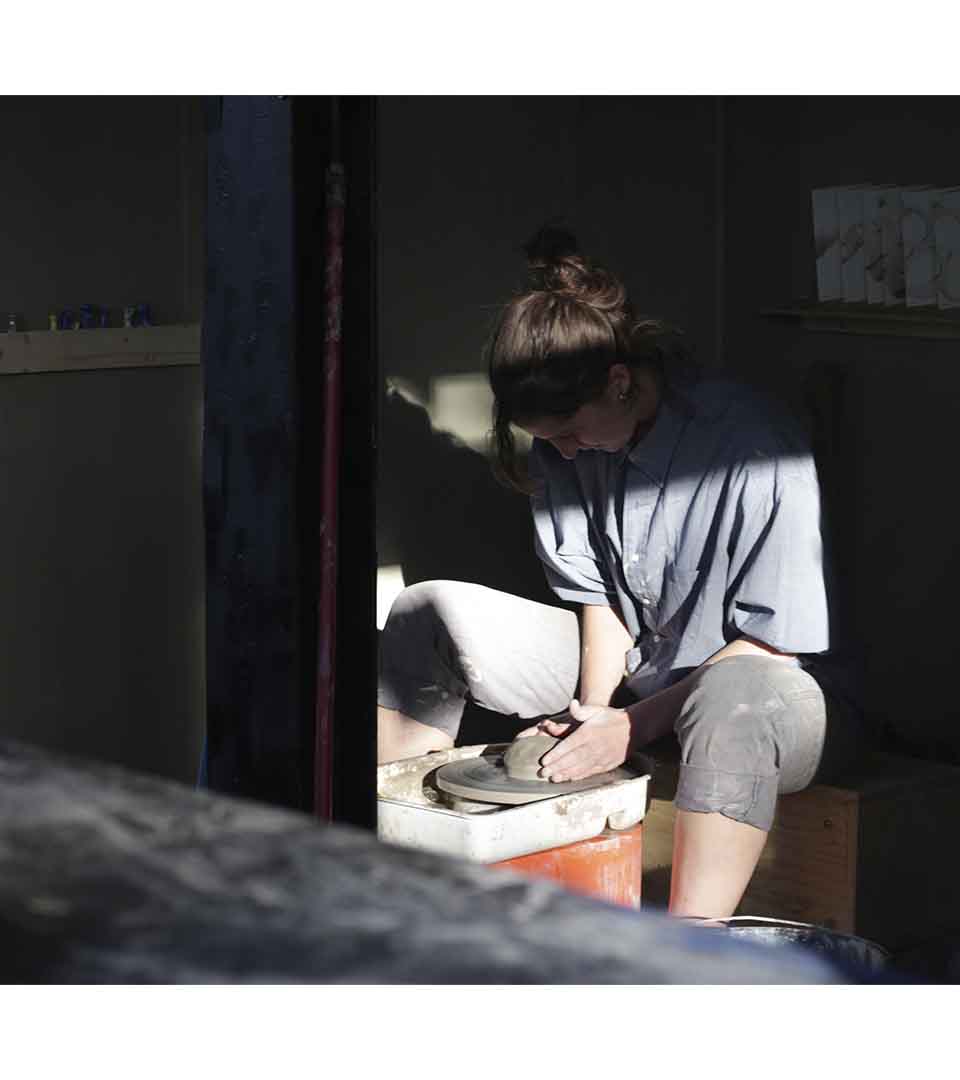
Sommerpavillon der Kultur- und Kreativwirtschaft
summer pavilion, berlin. summer 2024
a project by Kompetenzzentrum Kultur- und Kreativwirtschaft des Bundes as part of U-Institut
from June to September 2024, this temporary pavilion transformed a long-unused riverside space into a vibrant garden and cultural pavilion, where i contributed to structural design, green space planning, and cultural programming. With a focus on social impact, sustainability and circularity, i was co-responsible for exhibition selection, coordination, financial planning and reporting, and strategic development of the project. This role enhanced my skills in curating, administration, reporting and becoming patient and agile with (German) bureaucracies.
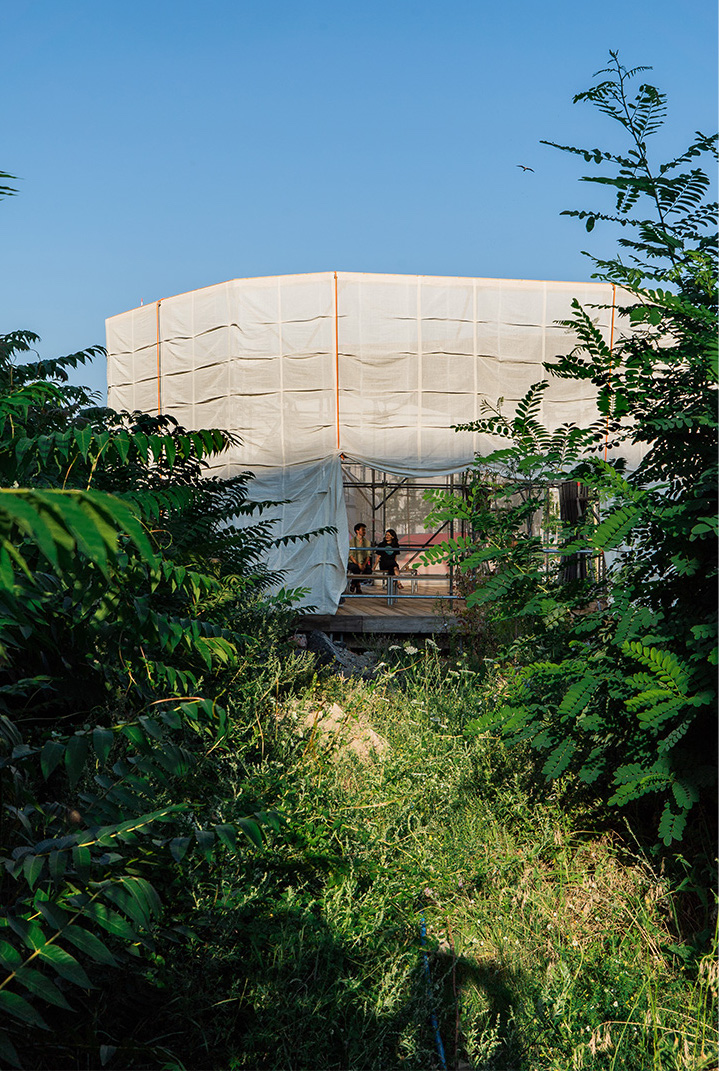
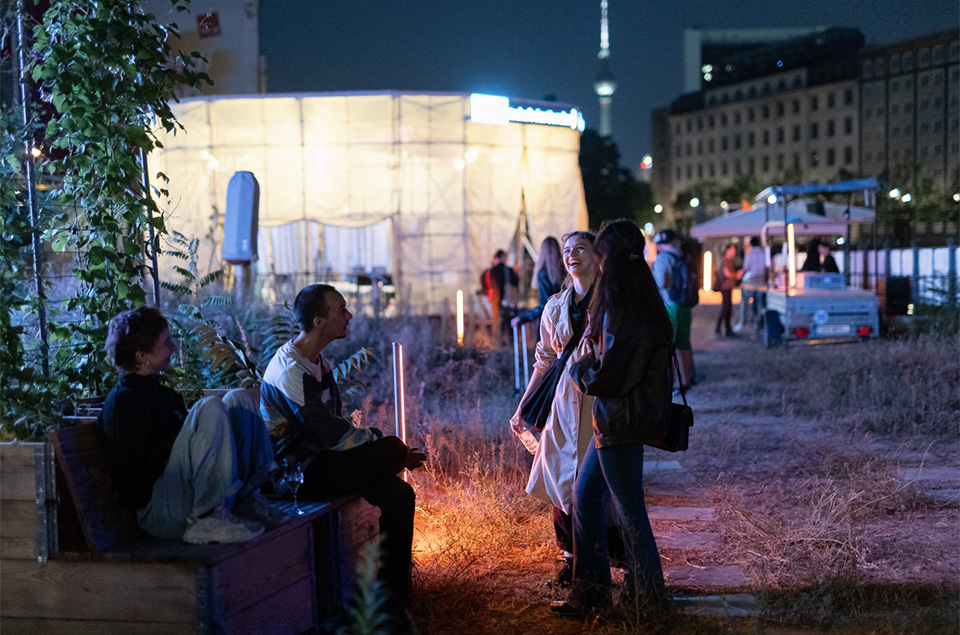
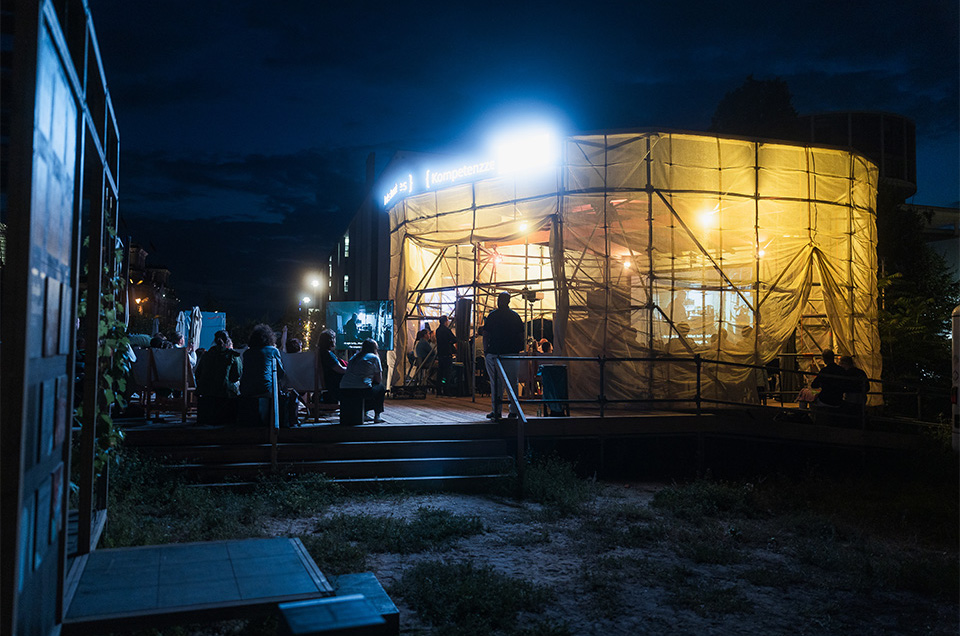
photocredits: William Veder, Sebastian Días de León
more thAn I
interactive installation, Akasha Hub, barcelona. june 2023
in collaboration with Akasha Hub Barcelona
the project encourages people to engage with more-than-human intelligences in a collaborative way. The installation “more thAn I” investigates potentialities of diversifying narratives (about presents, pasts, and futures) by initiating a collective storytelling that transcends into a 'more-than-human' space. It invites machine-learning into the conversation. A self-programmed AI language model (based on Open AIs GPT) poses thought-provoking questions to participants. Their answers shape an evolving story, projected in real time, while each new input influences the questions posed to those who follow.
by blending the perspectives of a dispersed human collective with the adaptive responses of artificial intelligence, the installation invites critical reflection on the structures behind human-machine interactions. Can this collaboration truly become a “mix”? What does it reveal about the possibilities and limitations of these hybrid narratives?
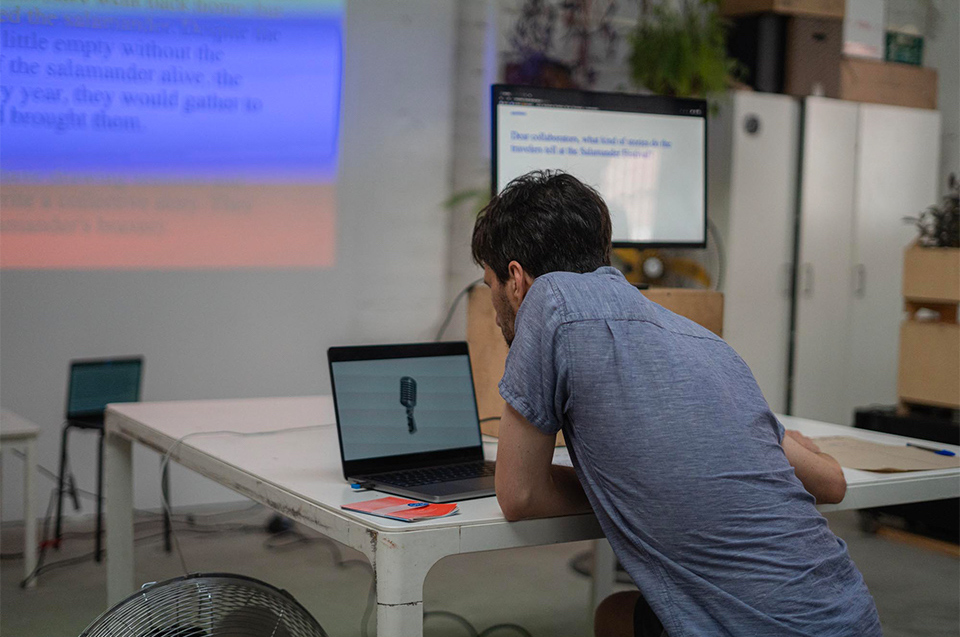
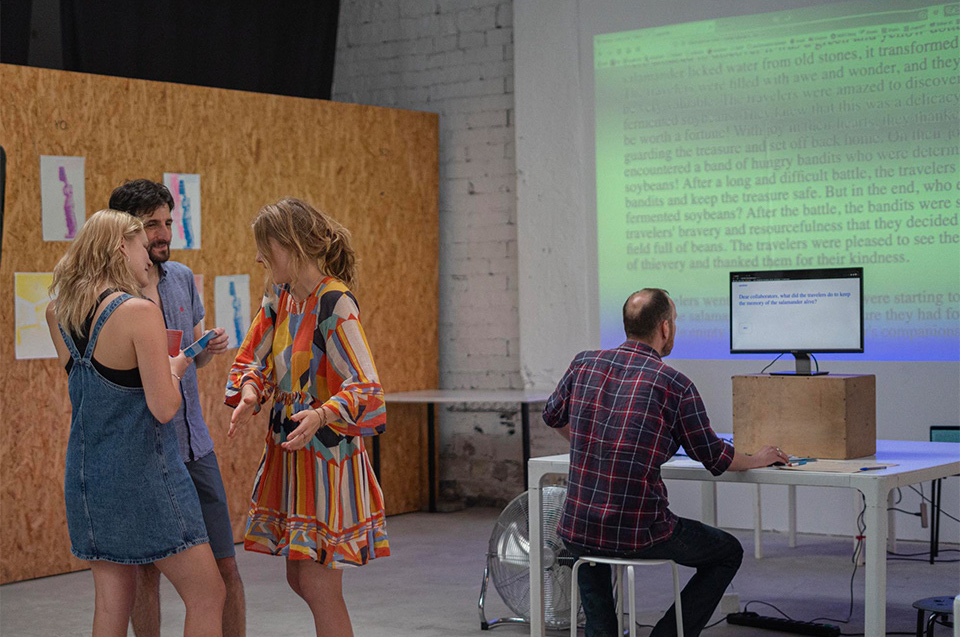
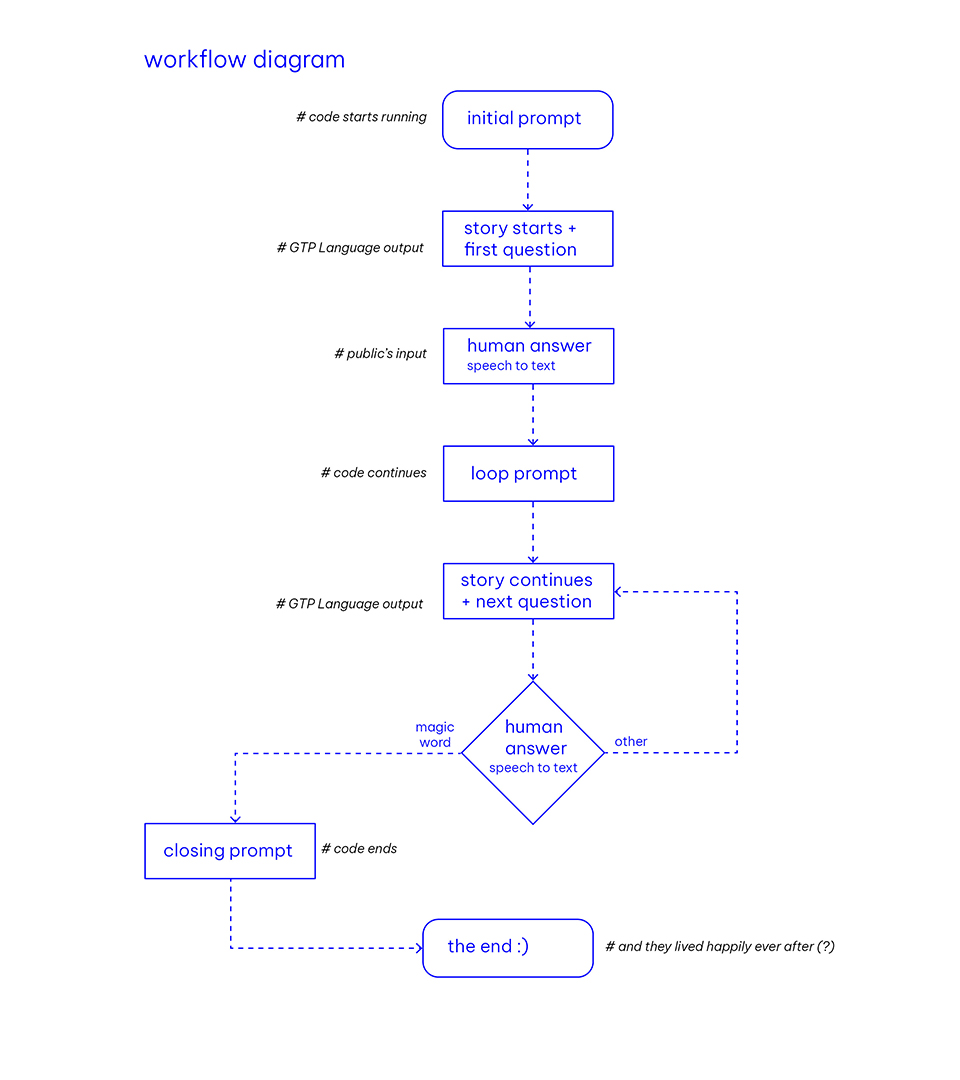
Museum of Colonialization (MOC)
experimenting decolonial practices. barcelona and the world. 2024 - ongoing
as a multidisciplinary collective we develop interventions imagining non-Western-centric futures and prototyping non-Western-centric presents. MOC is built on the idea that the entire world is a "museum of colonialization"—it’s just invisible to most. Through artifacts and prototypes, we challenge colonial and capitalist systems while highlighting the ongoing consequences of colonisation in our societies. Our journey began with an interactive installation resembling a gumball machine. Visitors press a “YES” button—agreeing to “visit the museum”—and receive a ball containing a sticker with a “fun fact” about colonial criminals celebrated across Barcelona. Next, we introduced a stamp-button for guerrilla acts of awareness. Pressing the button leaves a QR-code stamp that links to an online MOC-Map, marking the user’s GPS location. Simultaneously, a speaker announces “That’s so colonial,” sparking conversations and drawing attention to colonial legacies in public spaces.
we conceptualised a walking tour in Barcelona to fosters meaningful dialogue about the colonial history embedded in European cities and its relevance today. By connecting the past with the present, we aim to inspire visitors to question their assumptions and see the world through a new lens.
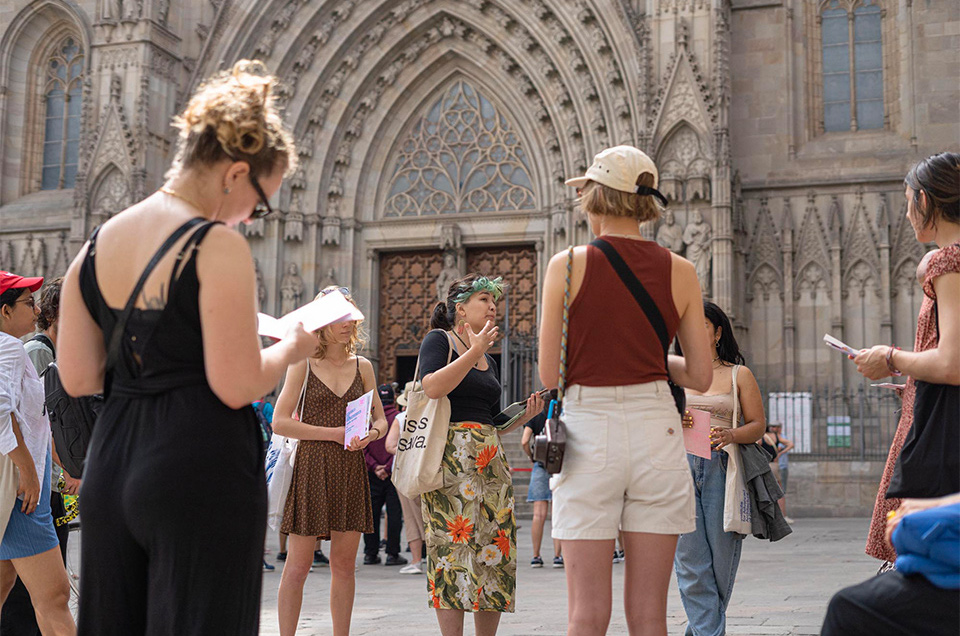
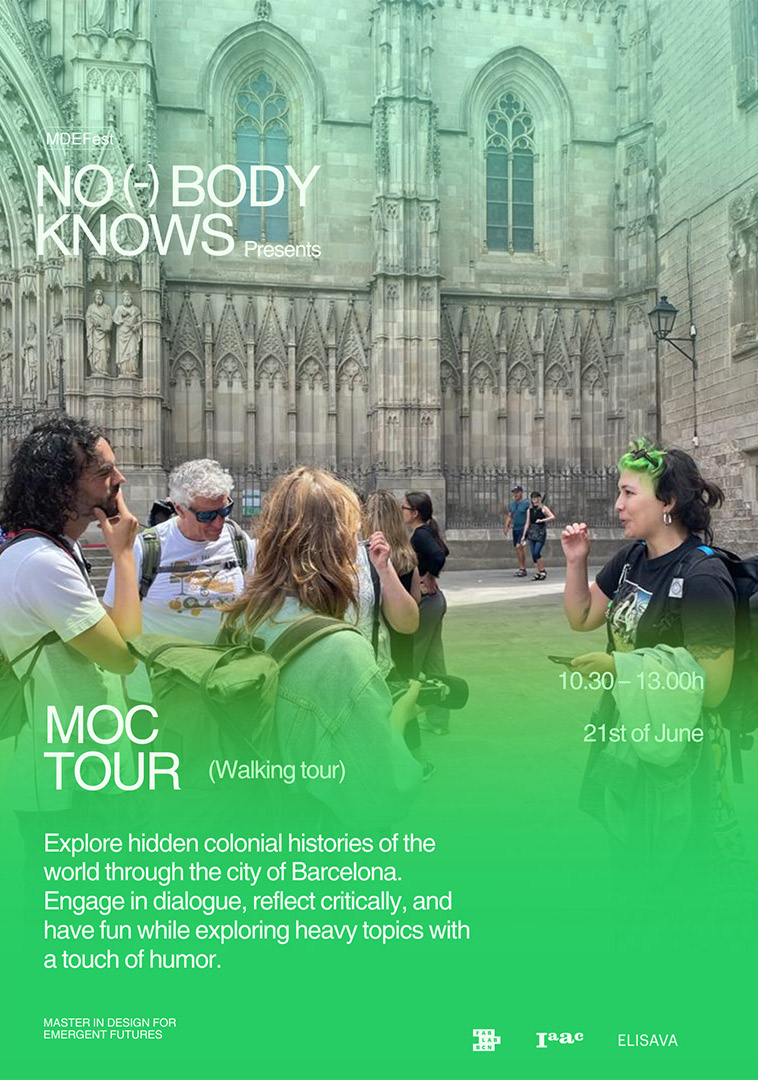
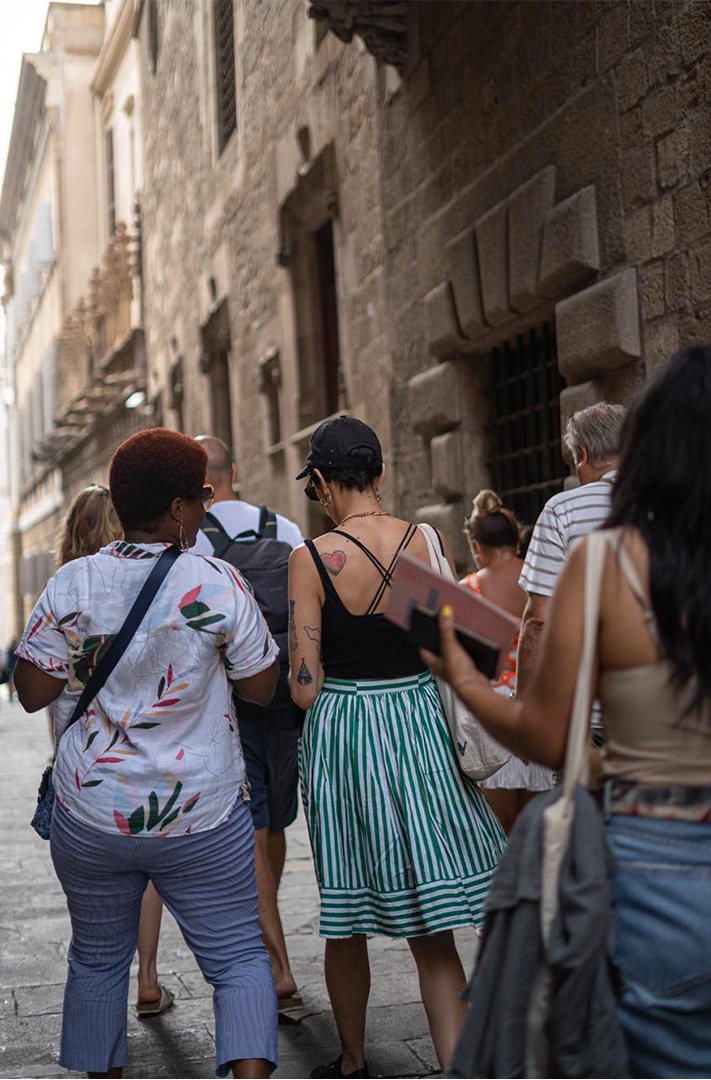
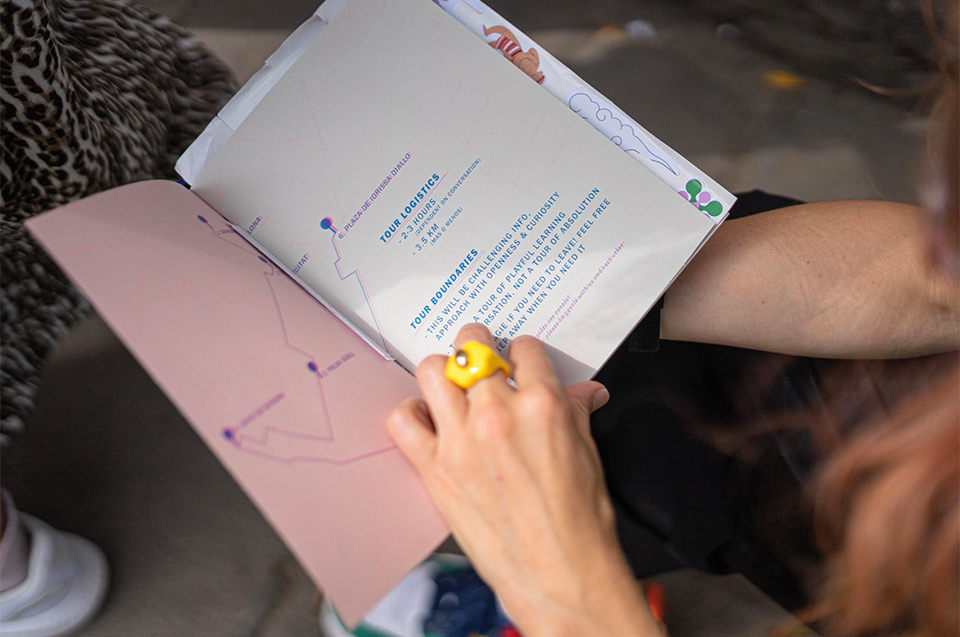
you can follow us on instagram
UP2US
interactive installation, exhibited in CaixaForum. barcelona. july 2023
in collaboration with FabLab Barcelona
initiated by Distributed Design Platform (DDP)
developed during the Circular Cities Challenge 2023
this project was developed as part of the Circular Cities Challenge by the Distributed Design Platform (DDP) and FabLab Barcelona. Our team of four worked to find an answer to the challenge faced by the energy sector in its attempt to transition to renewable energy sources: How to deal with the time mismatch between energy consumption and energy production? if energy from renewable sources is high during sunny or windy hours and no one uses it, we leave it unused (waste it?), while if consumption exceeds energy production from renewable sources at night, when the sun is no longer shining and the wind has calmed down, we make up the deficit with energy from non-renewable sources and batteries. Therefore, to fully transition to renewable energy sources, an awareness of the availability and physicality of energy is required.
UP2US aims to address the problem of unused hours at a community level. An installation in public space makes people aware of the energy mismatch. Corresponding colours and an accompanying digital interface translate data about the current availability of energy. Communities can independently adjust their behaviour to reduce pressure on the energy grid during peak hours and work towards a more balanced energy system that can be supported by renewable energy sources.
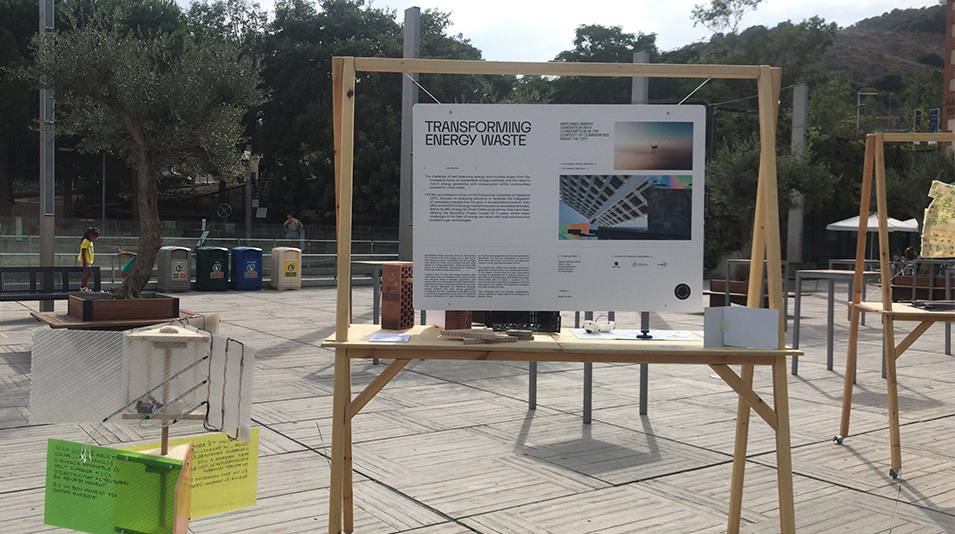

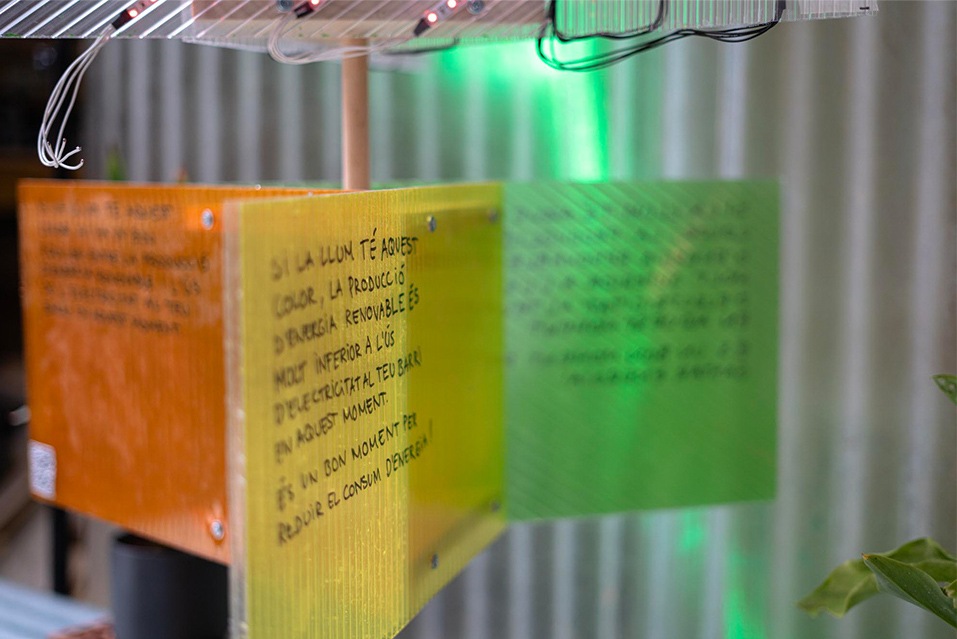
you can watch a video of our process on youtube.
storytelling workshops: speculative narration
facilitation of workshops. barcelona. 2023
under the concepts of Unfamiliarise, Grief, and Rebirth, these workshops created a space for participants to imagine alternative realities. The goal is to step beyond individual perspectives and engage with broader collectives—including facilitators (Myrto and me) and perhaps even more-than-human actants—to inspire new ways of thinking and being in the world.
one workshop, for instance, tackled the theme of “Transition in the Educational System: From In-person to Hybrid Forms of Learning and Teaching.” Together, we explored the challenges and opportunities of this shift, imagining innovative approaches to education for the future.
the workshops don’t end with discussion; they extend into experimentation. Outputs from these sessions are fed into AI language and visualization models, merging human creativity with machine imagination. This interplay blurs boundaries and reveals new potentials for collaborative storytelling across human and non-human realms.
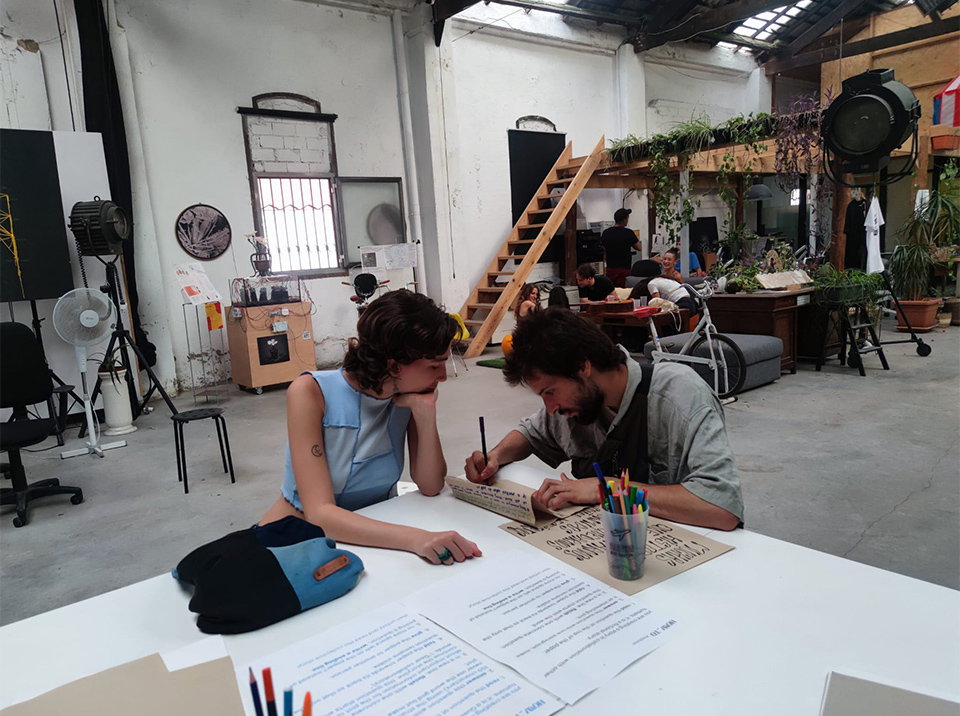

ghost machine
installation. barcelona. 2022
this project began with repurposing materials from two old computers. Using screens, speakers, LEDs, and an Arduino, i designed a "machine" that detects changes in light intensity, responding with sound and light to human presence.
the result is an installation that blurs the boundaries between the seen and unseen. Through storytelling, it invites viewers to connect with hidden energies - the "ghosts" around us, using flowers as an ethereal interface.
the Ghost Machine senses activities invisible to the human eye. A polarized glove allows the wearer to channel these roaming energies, bridging the gap between air, non-air, and the in-betweens. With lightwaves as their medium, these outer-human existences declare their presence and invite us to explore the intangible.
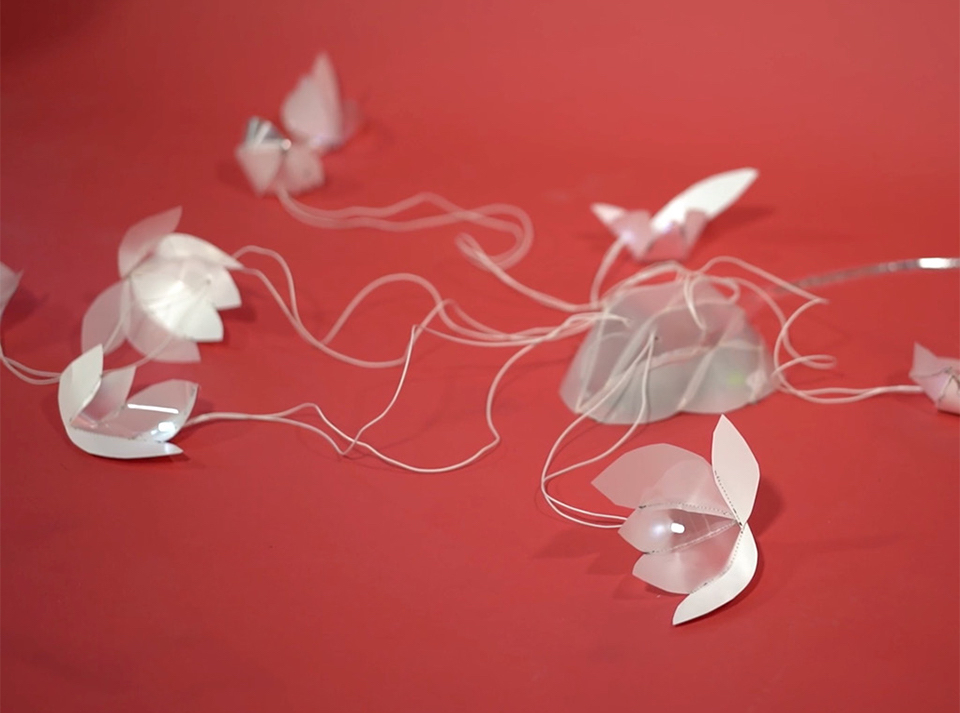
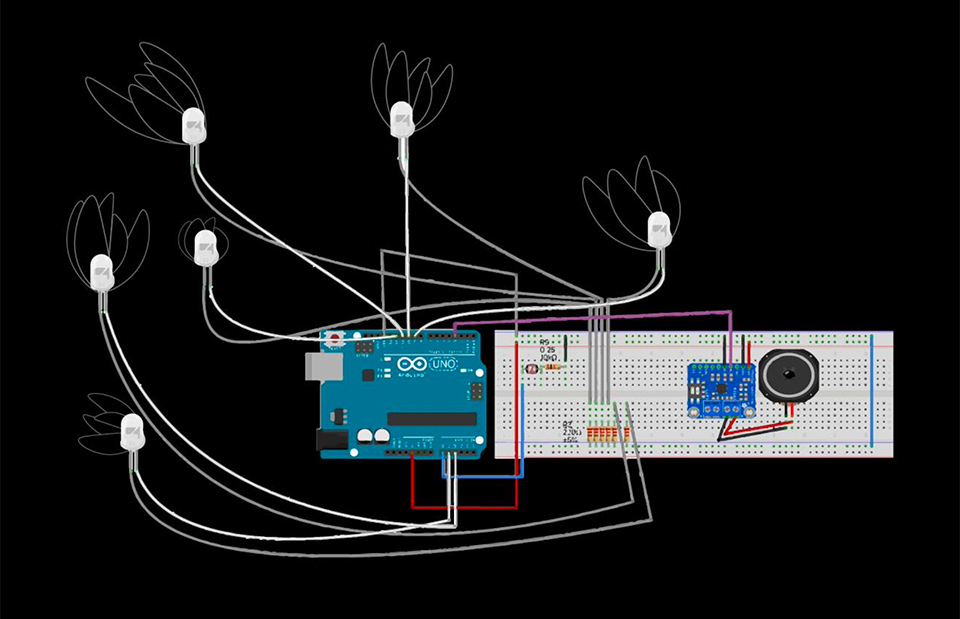
watch the video on vimeo (01:24)
refuge
sculpture. berlin. 2021
on May 10, 2021, a military strike killed seven civilians. In the aftermath, 119 more lives were lost in a conflict over land—over the right to simply exist on certain streets. The arbitrary lines governments draw on the ground dictate what is home and what is danger, who is safe and who is not.
this installation—a cube suspended in air, drifting with the wind—reimagines a safe space untethered by soil-bound consequences.
50/50 Refuge explores the concept of borders and their societal impact. The interplay between solids and air symbolizes interdependence: solids shape space, while air defines the voids. The work contrasts the volatility of air as a refuge with the rigid, divisiveness of borders. It invites viewers to reflect on the fragility of safety and the arbitrary delineations that shape our world.
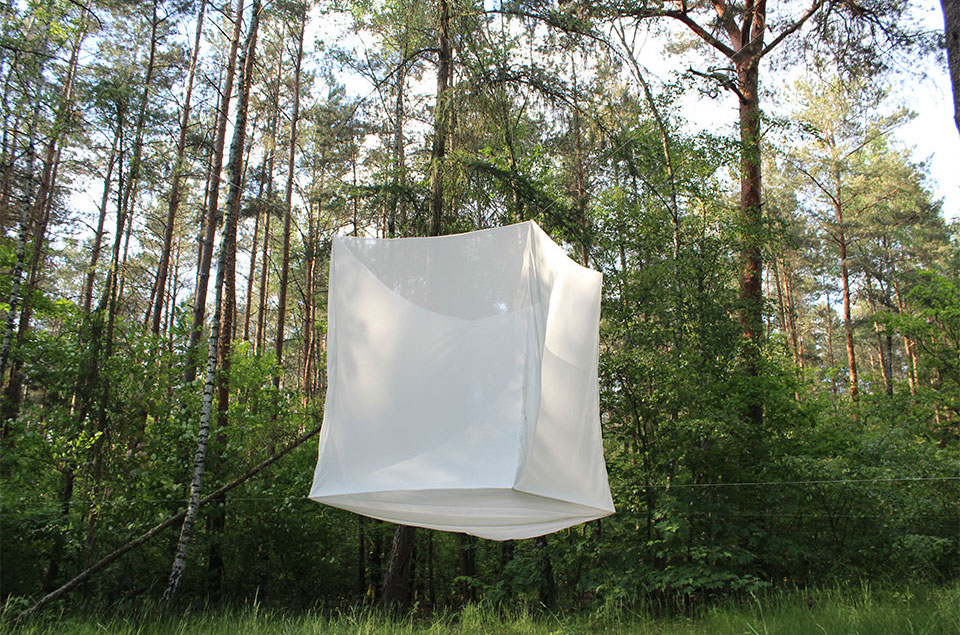
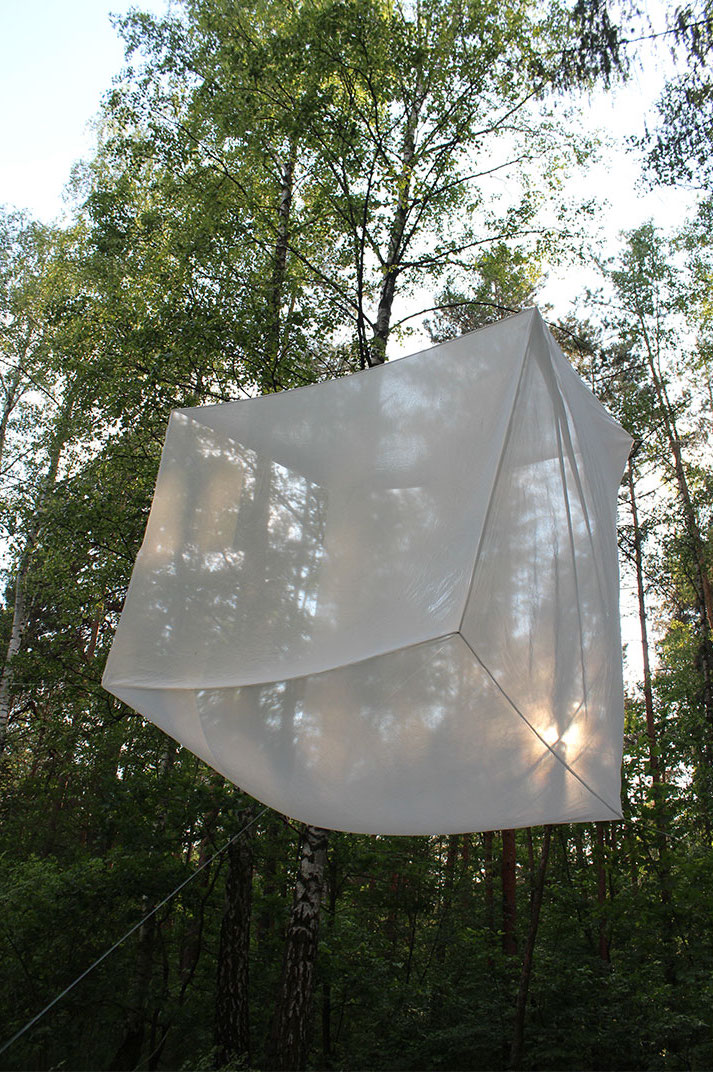
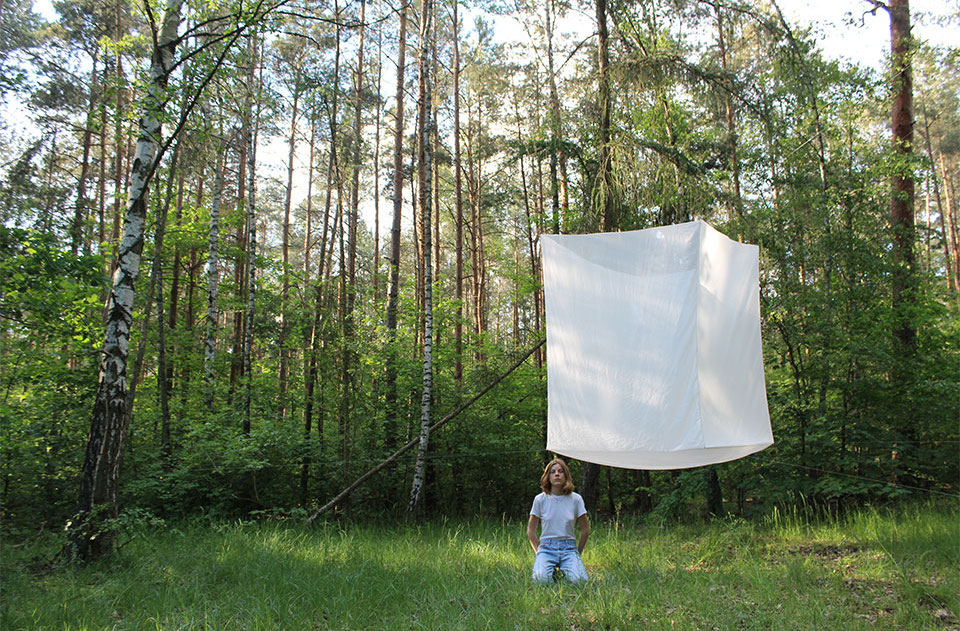
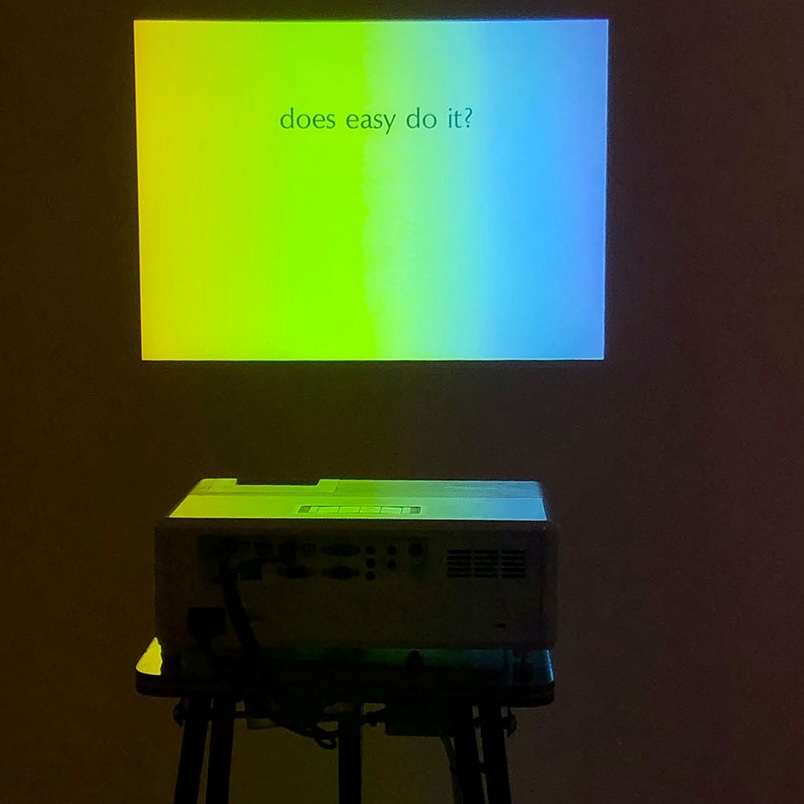
Gerrit Rietveld Academie graduation show 2022
models and plans. amsterdam. 2022
initiated by Gerrit Rietveld Academie
in collaboration with Dutch Steigers
as part of the architectural design department, i designed the outdoor space for the graduation show 2022 of the Gerrit Rietveld Academie in Amsterdam. A place for casual encounters as well as formal dines, and speeches. We collaborated with the Amsterdam based company Dutch Steigers who helped us with the engeneering of the scaffolding. Because of finantial reasons the project was not realised in the end.
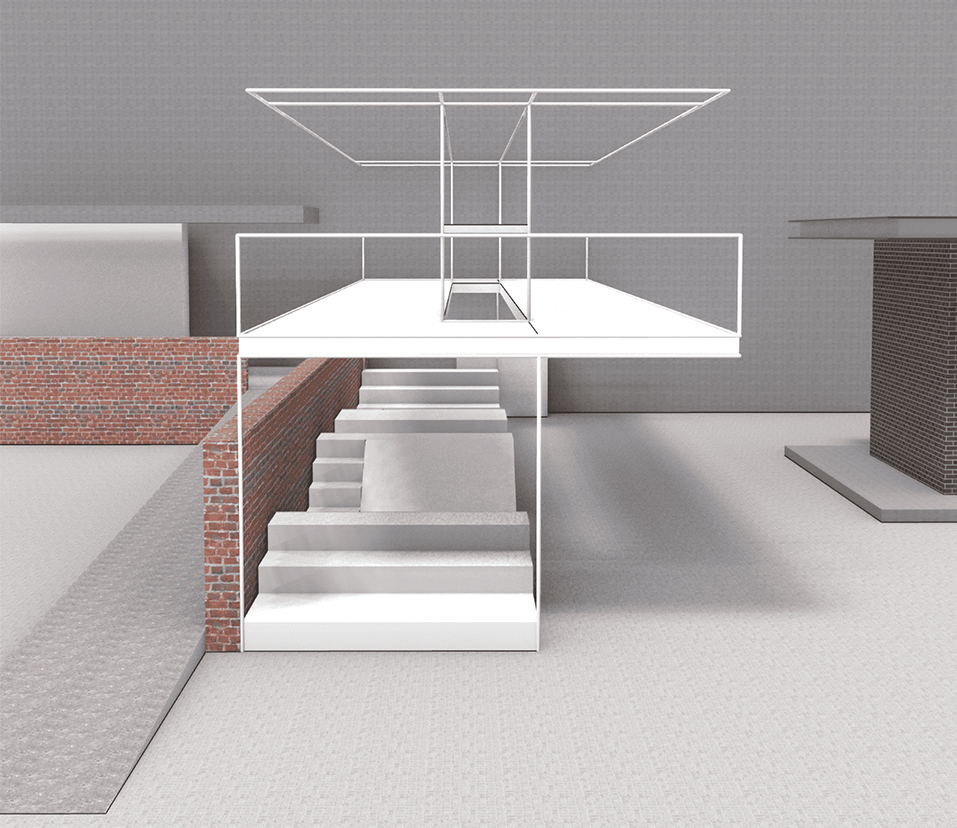
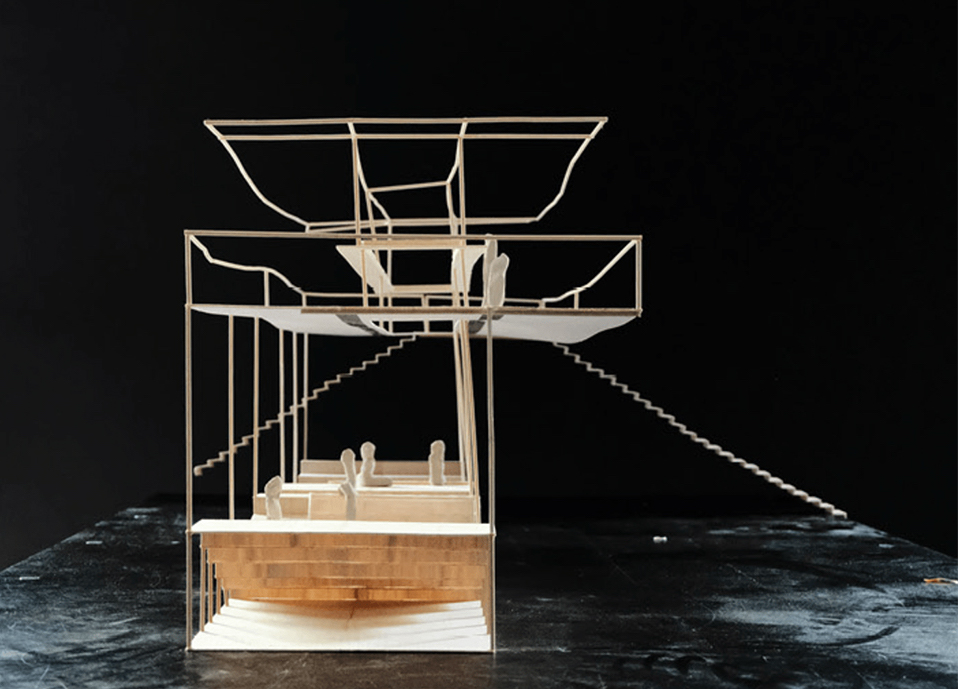
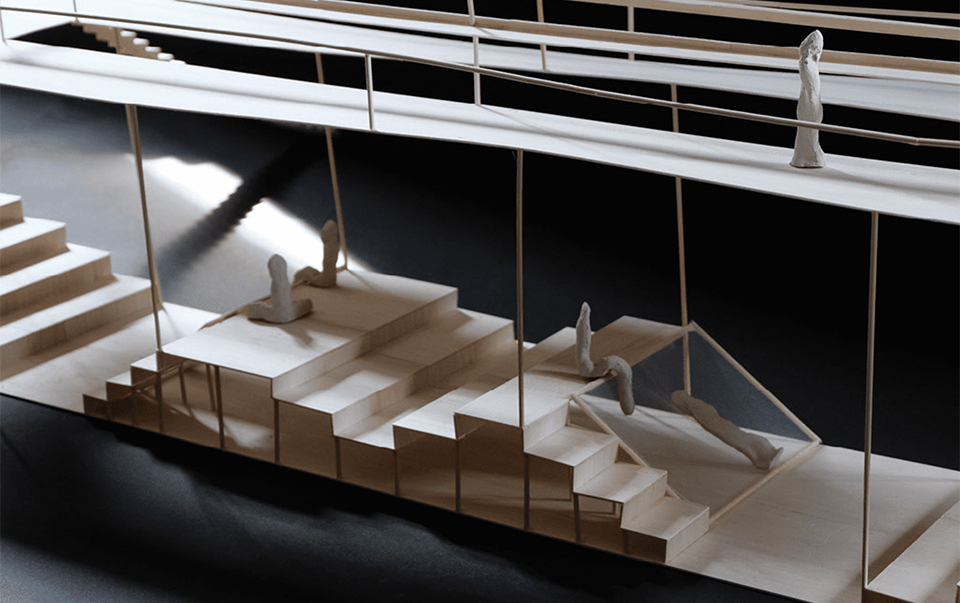
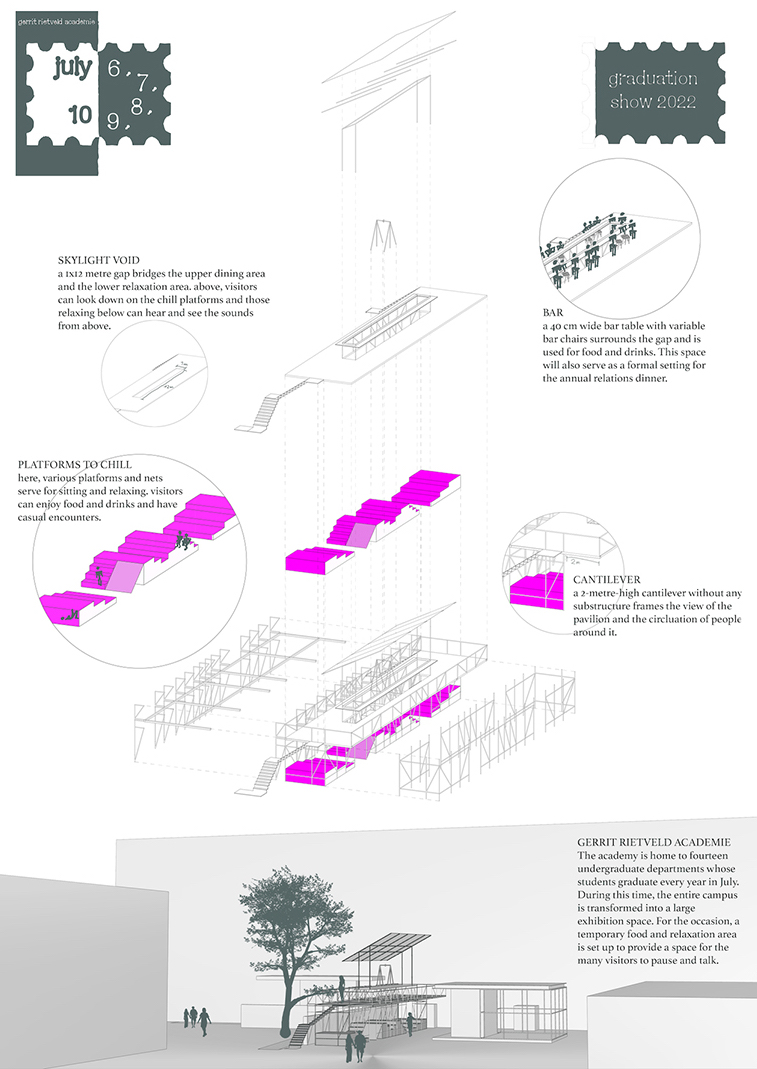
safe places
reconstruction of memories. berlin. 2023
in 2016, i went to Ecuador to help build a school in Aiguas Frias in the Atacames region, which is very affected by earthquakes and had recently experienced the effects of a 7.9 magnitude quake. i stayed with a host family who took care of a large wooden house. The family consists of eight people of almost all ages. They experienced the tremors and soon after they became afraid of what it means to live far from the ground. They moved into the chicken shed, which was no bigger than a few square metres. i slept in the big house alone. The white European privileged girl could not to squeeze in with the eight people and their chickens on the dirty floor. i felt scared there on my own.
in this sequence of images, models, collages and animations, i am trying to reconstruct and simulate the feeling the tremors must have left them with. i use my own memories of staying there, the images i have from that time and place and related footage i get from open-source.
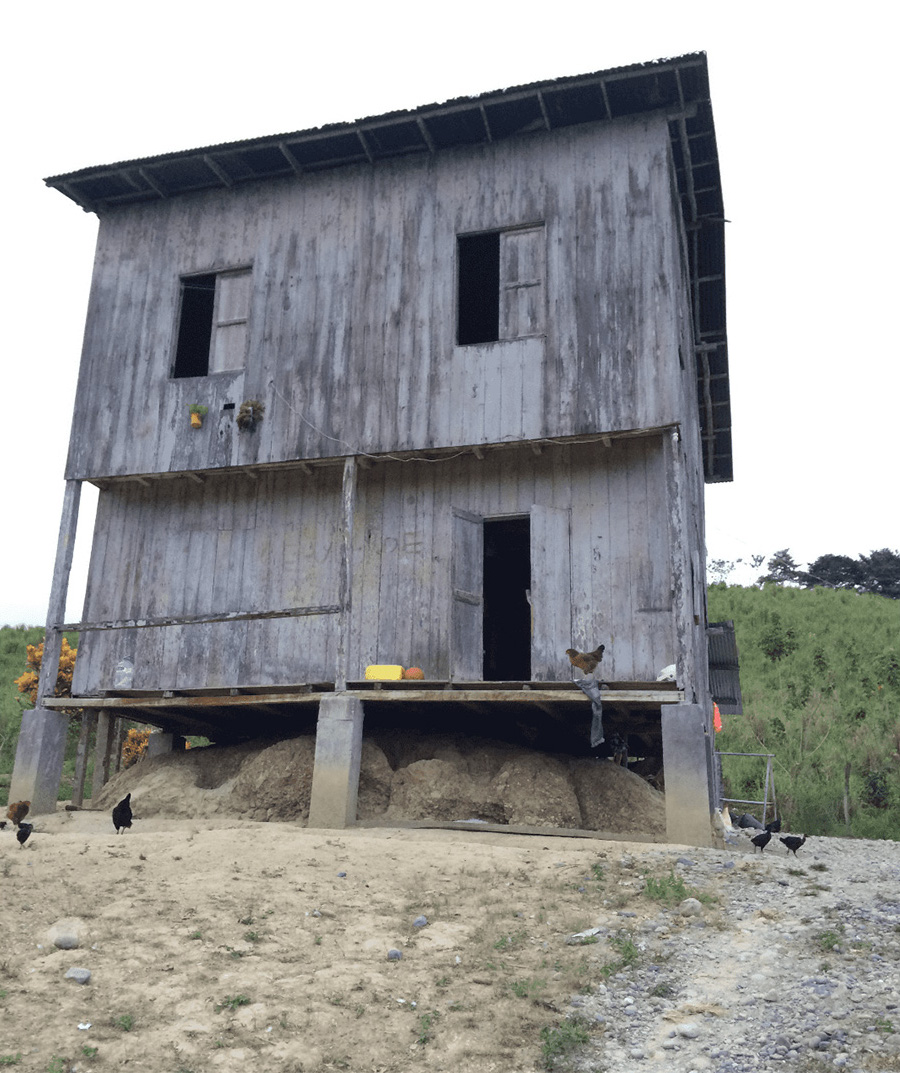
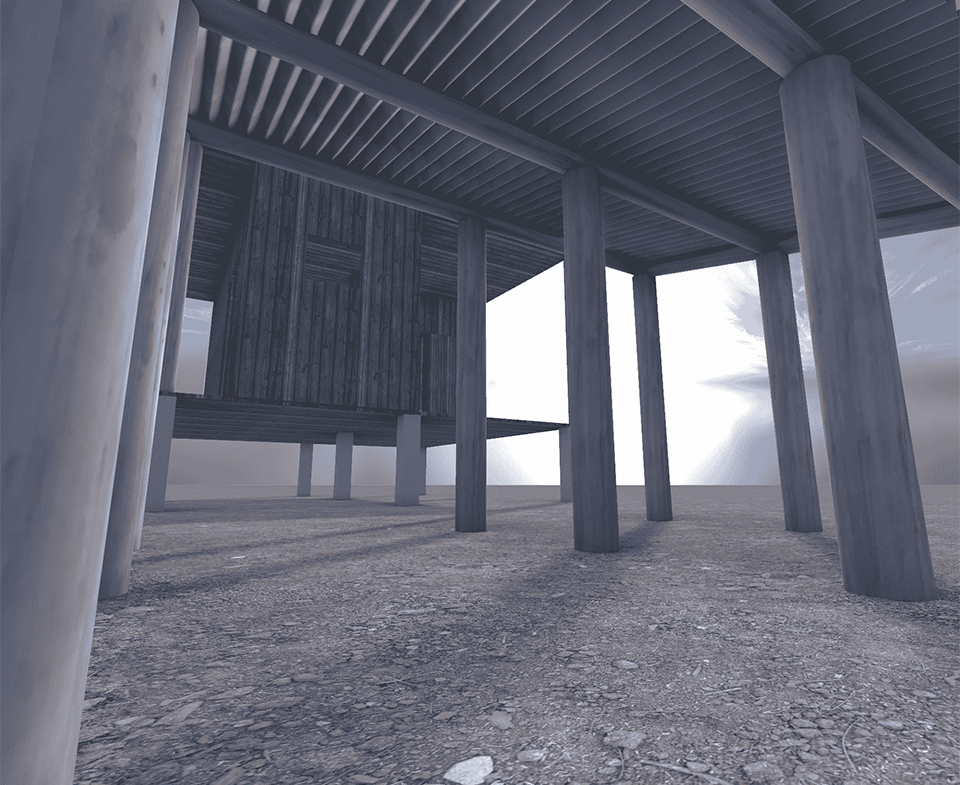
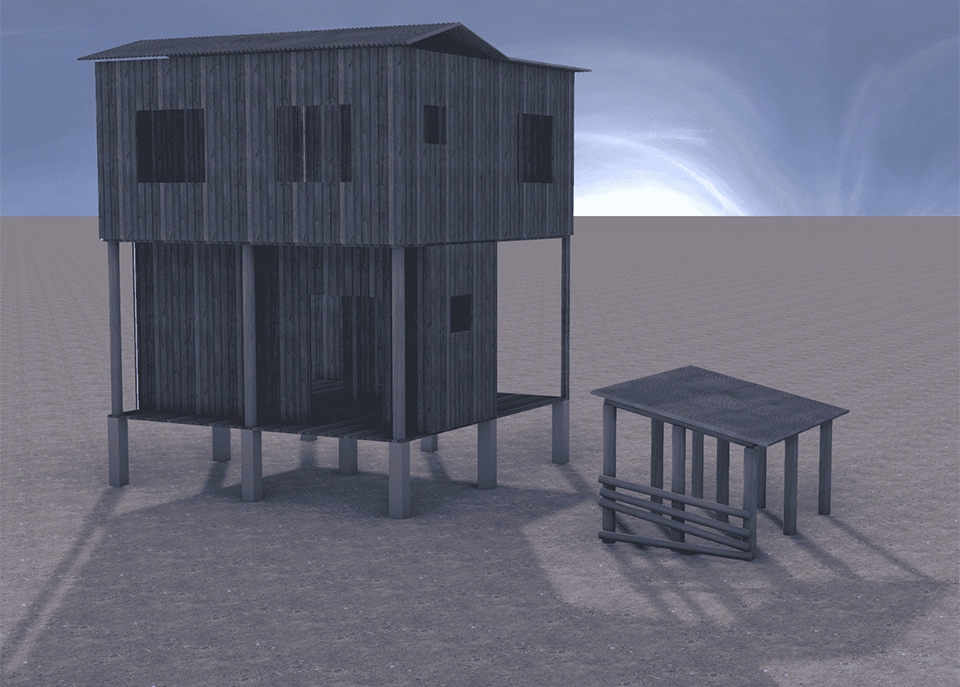
campus studies
speculative exploration. amsterdam. 2022
at the heart of the Gerrit Rietveld Academie’s outdoor campus stands a pavilion originally designed by Rietveld himself as a sculpting workshop. Over time, it has evolved into a student-run exhibition space, but despite its central location, it lacks the infrastructure to foster meaningful interaction and relaxation.
through an ethnographic study, I explored the pavilion’s role on campus. While it serves as a vibrant exhibition venue, the research revealed a broader need: the campus lacks spaces that encourage connection, creativity, and exchange. This gap leaves the courtyard feeling disjointed and transient, rather than a cohesive hub for inspiration.
my proposal envisions a redesign of the pavilion’s infrastructure, enhancing its visibility and transforming it into a space that balances its role as an exhibition area with new elements for collaboration and pause. Inspired by Gerrit Rietveld’s principles of interaction and co-creation, the design aims to honor its original spirit while meeting the needs of the present campus community.
